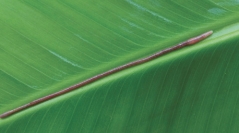

 Zoosystema
46 (17) - Pages 411-455
Zoosystema
46 (17) - Pages 411-455The French West Indies are part of the biodiversity “hot spot” of the Caribbean islands. The landscape of these islands has constantly evolved and been shaped by the agricultural context. Today the agricultural landscape is dominated by banana plantations, sugar cane fields, pastures and market gardens, which can harbour an important biodiversity of earthworms (Annelida, Clitellata). Several studies were interested in earthworms in natural environments of Guadeloupe and the agronomic role of earthworms in agricultural environments was also studied until the 1990s; but no synthesis exists to date. The objective of this work is to establish a complete list of earthworm species in agricultural environments in the French West Indies based on a synthesis of the literature and new collects. The results of the literature synthesis show the presence of 10 species already mentioned in agricultural environments. Our recent collections allowed us to identify seven species new for the French West Indies: Dichogaster (Dt.) annae (Horst, 1893), Dichogaster (Dt.) saliens (Beddard, 1893), Drawida barwelli (Beddard, 1886), Polypheretima taprobanae (Beddard, 1892) Onychochaeta windlei (Beddard, 1890), Periscolex brachycystis (Cognetti de Martiis, 1905) and Periscolex nevoi Csuzdi & Pavlíček, 2009. These new data also extend the distribution of several species to islands where no records previously existed in the literature. However, knowledge is unequally distributed among the islands, depending mainly on the sampling effort. The agricultural environments of Martinique are the best known, the rarefaction curve is close to saturation at 16 species reflecting a substantial sampling effort. On the other hand, we can expect the discovery of additional species in the cultivated environments of Guadeloupe because the rarefaction curve is far from the saturation point with only nine species. For the 15 species for which individuals from recent collections were available, the analysis of a mitochondrial gene fragment of cytochrome c oxidase I (COI) was performed. This was done in order to constitute a reference library of DNA barcodes whose morphological identification is verified to facilitate future work on the taxonomy of earthworms in this area. All these data are integrated in a detailed determination key allowing to identify 21 species, i.e., the 17 whose presence is confirmed as well as four additional species whose presence is highly probable but not yet attested in the cultivated areas of the French West Indies.
Crassiclitellata, Moniligastrida, Lesser Antilles, soil biodiversity, Martinique, Guadeloupe, Saint-Martin, Caribbean basin, illustrated key, checklist